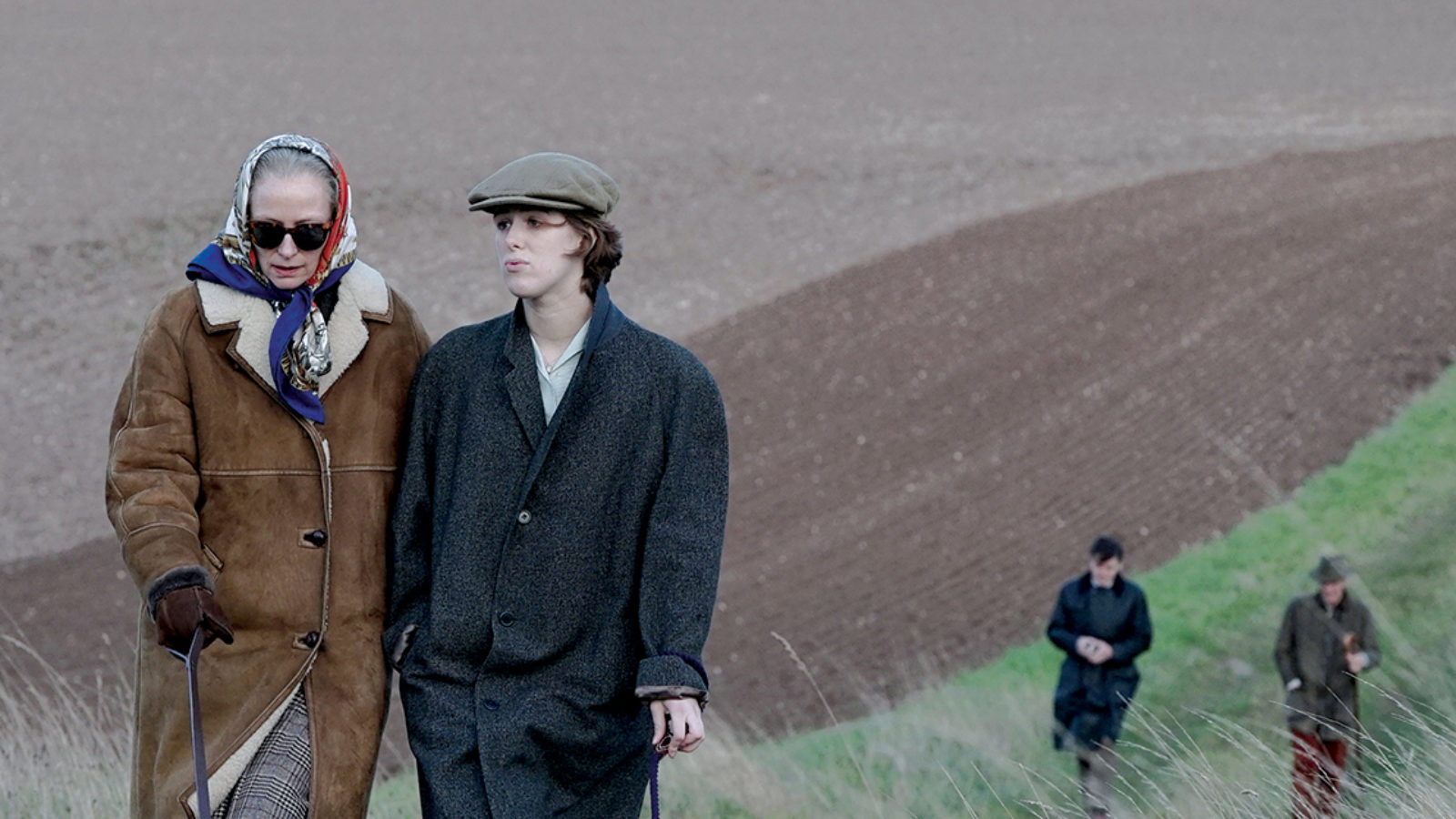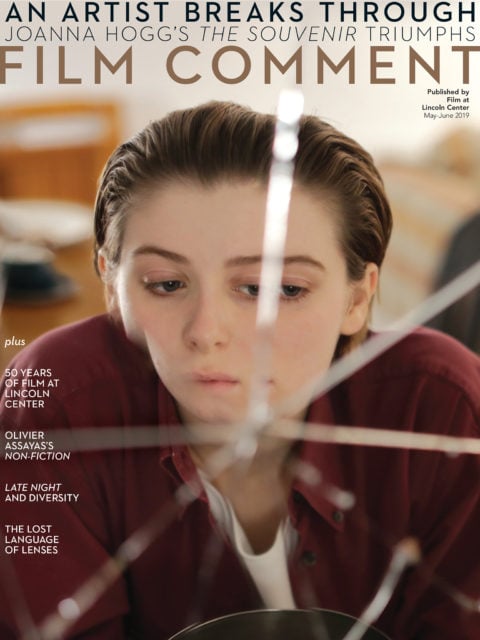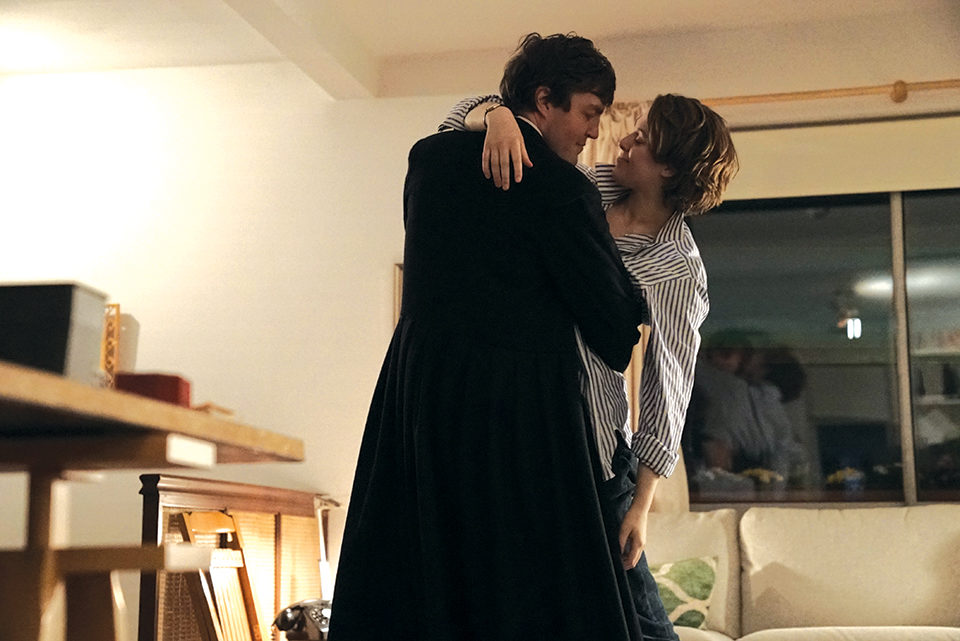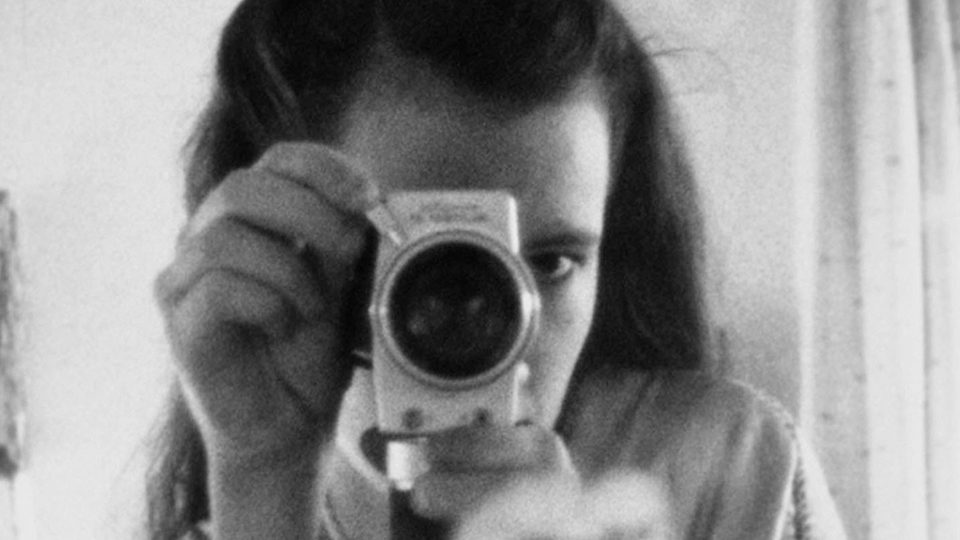By Sheila O'Malley in the May-June 2019 Issue

I Know Where I’m Going
In Joanna Hogg’s sublime breakout The Souvenir, a budding artist strives to stay true to her path despite a consuming romance
Jean-Honoré Fragonard’s painting The Souvenir, completed in the mid-to-late 1770s, depicts a romantic sentimental scene—pure “rococo,” shimmering with love, light, frivolity. A young woman in a pink dress, tight in the bodice with flowing voluminous skirt, carves an initial into a tree. Beside her a dog perches on a stone pedestal (with Fragonard’s signature etched in the side), and a letter from her lover lies on the ground. A white sky glows around her body. There is no sign of the political upheaval in France at the time. The outer world does not exist. According to the first sale catalog, the girl is supposed to be “Julie,” the lead character in Jean-Jacques Rousseau’s 1761 epistolary novel Julie, or the New Heloise. Fragonard’s painting plays a large role in Joanna Hogg’s new film, The Souvenir, with connections spoken and unspoken, textual and subtextual. Like all effective symbols, Fragonard’s painting gathers in force and scope long after the final credits roll. The Souvenir—painting and film—contains multitudes.

From the May-June 2019 Issue
Also in this issue
The central character on screen is also named Julie, and she is played by Honor Swinton Byrne (daughter of Tilda Swinton) in one of the most extraordinary breakout performances in recent memory (after previously appearing in I Am Love). Julie is in film school in London, struggling to bring a project to fruition. Her idea is a film about a mother and son living in Sunderland, among the wreckage of the shipbuilding industry, sinking out of existence like a doomed Atlantis during the 1980s, when the film takes place. At a pitch meeting with potential backers, she is asked a tough question: “What makes you want to leave your own experience so radically?” Julie replies, “I don’t want to be in that bubble.”
The “bubble” is her economic privilege. Surrounded by film students from all walks of life, she is self-conscious of her background. What happens over the course of The Souvenir, though, is that Julie goes deeper into her so-called bubble, led by life experience, artistic experimentation, conversation, travel, her first love, and finding that her “bubble” has endless space within it. If she is ever going to be an artist, a filmmaker, she needs to create from her own point of view. This is only a part of The Souvenir, with its slow accumulation of small moments, overheard fragments, letters read out loud, objects and books discussed, backgrounded by off-screen political events like IRA car bombs and Libyan hostage crises. Julie, politically aware and liberal, caring about the downtrodden and forgotten in Thatcher’s England, and yet caught up in romance’s pleasures and pains, is a kindred spirit to Fragonard’s Julie, and Rousseau’s.
Into Julie’s life comes a charismatic older man named Anthony (Tom Burke), who works for the foreign office in the government in some mysterious fashion, and spends his life eating in fancy clubs, traveling, and wearing fancy socks and loafers, in stark contrast to Julie’s eclectic group of filmmaking buddies. Anthony circulates in the rarified air of the upper crust, with the superior attitude that comes with it. He fits right in with Julie’s parents, in particular her mother (Tilda Swinton), a doughty, proper woman in wool socks, tweed skirts, and a patterned head scarf, baffled at her daughter’s bohemian life, but supportive in a vague way. Anthony challenges Julie, loves Julie, uses Julie as a port in an increasing storm. Their relationship has extremely toxic elements, but it has its deep joys too. He pushes her to be more articulate and confident in her ambitions for herself.
However, the relationship, so engrossing, isolates young Julie from joy, from work, from her peers. The process happens by stealth. Anthony has a secret, something the rather naïve Julie doesn’t pick up on at first: he’s a heroin addict, well known to his friends as a junkie. Julie sees the scars on his arm and either doesn’t put it together, or doesn’t want to put it together. Anthony does many horrible things, frightening things, he is both controlling and chaotic, but—to quote Tracy Lord in The Philadelphia Story—“The time to make up your mind about people is never.” Everyone is a mixed bag. Anthony is not a villain. This is the tough part about love. Julie falls in love with him for a reason, and Burke—in his deep, intuitive performance—shows us why. It’s so easy to look back on relationships and perceive all the red flags ignored in the beginning. Retrospect is 20/20.

The Souvenir (Joanna Hogg, 2019). Photo by Nicola Dove, courtesy of A24
The autobiographical origins of The Souvenir are obvious (Hogg doesn’t try to hide them), yet she allows for free-floating associations, creating a kind of space where connections are possible, where there can be a wincing kind of recognition, a remembrance of first love and first heartbreak. The response is a not always comfortable: “Yes. My God, I know that. That is so true.” As a young woman in the late 1970s, Hogg was also drawn to Sunderland’s ruins, and spent a lot of time there taking black-and-white photographs of the desolate landscape (The Souvenir opens with a montage of those photos). This photography helped Hogg get into the National Film School, ushering in the next phase of her artistic development. In film school, she moved away from gritty Ken Loach–style social realism, rediscovering her love of old Hollywood musicals. A boyfriend introduced her to the films of Powell and Pressburger (she had forgotten that she had seen The Red Shoes as a child), and fell in love with the “otherworldly vision” of films like The Tales of Hoffmann and A Canterbury Tale. The highly stylized All That Jazz and New York, New York were huge influences on her, as she wrote in a 2014 article for frieze: “What I took away from Martin Scorsese’s New York, New York was a strikingly vivid expression of how two artists don’t necessarily make a good marriage. Bob Fosse’s All That Jazz isn’t just a musical, it’s an autobiographical film with music. I watched both films again recently and they inspire me more than ever.”
All of these influences can be felt in The Souvenir, glimpsed through Hogg’s very particular and idiosyncratic eye. Her work, with static camera and sensitivity to architecture (most obvious in her gorgeous 2013 film Exhibition), with people moving in and out of rooms, has often been compared to that of Yasujiro Ozu, but she has provided another influence for additional context: “The fixed camera, that came out of being interested in gesture and how people move . . . it probably goes back to my love of watching Gene Kelly tap dance, you’d have a wide shot and you’d see a full figure moving about in the frame.”
Caprice, her 1986 thesis film, stars a then-unknown Tilda Swinton (The Souvenir represents a beautiful reunion of two artists who started out together). Caprice follows the surreal adventures of a mousy young woman who—Alice in Wonderland– like—finds herself trapped in the pages of “Caprice,” her favorite women’s magazine. She is drawn deeper and deeper into a dystopian-style maze of perfume ads, fashion layouts, and society pages, all of which try to trap her in their perilous clutches. Caprice is witty and inventive, stylistically ambitious, with dramatic lighting and elaborate sets (including a gigantic slightly curving stairway, reminiscent of Busby Berkeley musical numbers). There’s even an entire music video, with girls in colored dresses doing a fully choreographed dance in front of a nightclub. Caprice is the opposite of social realism, and can be seen as a declaration of Hogg’s independence, a statement of purpose and personality. Her mentors at the film school did not understand it, but Caprice was Hogg diving into the “bubble” of her obsessions, movies and Hollywood and music, and the film has real bite, with its lampoon of advertising’s damaging effects on women’s consciousness and identity.
After film school, Hogg worked in television for many years, thriving in the rigors of series work. Two decades after Caprice, she directed her first feature, the beautiful Unrelated (2007), depicting a group of people vacationing in Tuscany, where the menopausal and childless Anna (Kathryn Worth) is drawn into the shenanigans of a younger crowd, attracted by the sexually carefree Oakley (Tom Hiddleston, a frequent Hogg collaborator). All of Hogg’s stylistic quirks are already in place in Unrelated: people move in and out of a fixed frame; huge arguments take place in other rooms, overheard only. The story’s propulsion forward has an improvisatory looseness, as we are dropped in and out of moments at random. Hogg does not add up 2 + 2 for us. She lets us do the math. Archipelago (2010) also portrays a family vacation, this time on the wild and windy Isles of Scilly. The family wanders through the landscape, painting and preparing meals, as painful issues surging beneath the surface slowly bubble up. Hogg rarely uses close-ups. She stands back from her characters, letting them move around, disappearing and then reappearing, personality, story, and subtext revealed through interaction and body language. Hogg resists the urge to move in close and yet the effect is not “distancing” at all. It’s sometimes painfully intimate.

Hogg has written that one of her inspirations is Roberto Rossellini’s Journey to Italy, saying, “I strive to create this degree of aliveness. I need to see this film often to understand what it is I am trying to do.” Most of our time in life is not spent in dramatic standoffs and cathartic breakdowns. Most of the time we are cooking and eating, taking walks, making phone calls, having deep conversations (or shallow), having sex, having arguments. Hogg clearly has a plan and knows what she wants to create, but within that plan she allows for extraordinary freedom. Perhaps the limits she imposes, by proceeding in chronological order, by keeping the camera in doorways or on the far side of a room, encourages the exhilarating sense of “aliveness” felt in Unrelated, Archipelago, Exhibition, and The Souvenir. Helle le Fevre has edited all of Hogg’s features, and her contribution is essential.
Julie, very attached to her Sunderland project, but stymied by it too, begins to think outside the box and within her “bubble,” hoping to find her way into unfettered self-expression. Maybe Ken Loach isn’t her guiding star after all. Maybe it’s Powell and Pressburger, and maybe that’s okay. In between film classes, where discussions range from the shower scene in Psycho to the “almost impressive” fact that England has never had a “good musical,” Julie returns home to her apartment, where she and Anthony live and work and love. As the relationship crumbles, she grasps him closer, trying to save him from his demons. They travel to Venice. Anthony brings her to get fitted for a tight gray suit, a gown with a long trail for a night at the opera. By day, she hangs out on drafty soundstages with film students and actresses. Her life is completely cut in two by this relationship. Swinton Byrne has little prior acting experience but she is able to be in front of the camera, a gift that can’t be taught. She does not strive or push. Things happen to her. The impact of events—humor and pain and uncertainty—ripples across her face. She lets us in; she lets us see her.
Things with Anthony deteriorate just as Julie begins to rise and flourish, an eerily accurate insight into the power dynamics in dysfunctional relationships. Julie drops the Sunderland project and devotes herself to developing an abstract and stylized performance-art piece, where a glamorous actress recites Christina Rossetti’s “Song,” with its heart-wrenching opening verse, echoing Julie’s increasing fears for Anthony:
When I am dead, my dearest,
Sing no sad songs for me;
Plant thou no roses at my head,
Nor shady cypress tree:
Be the green grass above me
With showers and dewdrops wet;
And if thou wilt, remember,
And if thou wilt, forget.
There’s a gorgeous shot of Julie’s crew—cinematographer, camera operator, sound operator—pushing in close to the actress reciting those painful lines, the three people moving as one in a state of total unblinking focus on the task at hand. The moment is lit like a Caravaggio, with inky-black shadows and soft light sculpting the figures. It’s the romanticism of being in an artistic headspace, of putting yourself and your dreams and passions out there for people to see. Julie stands off to the side, looking on at what she has created. All of these people have come together to bring her vision to fruition. Collaboration like this is its own addiction. It gives life meaning, especially when all else falls apart. (Julie’s story is not over, not by a long shot: preproduction for the sequel to The Souvenir is already underway.)
In Archipelago, a painter (played by real-life painter Christopher Baker) explains to Edward (Hiddleston, again) the choices he makes as an artist: “If I got rid of those blues there, then the other colors become the blues. They exist in relationship to the other colors. They take on a blueness. It’s kind of what I’m trying to do. A slightly more intriguing tangent. Understatement.”
Since Baker is actually a painter, the moment is documentary-like in its directness (Hogg often casts non-actors). The painter shows us how to see as he does, shows us not just the “how” but the “why” of his process. How we think about art and talk about it, in ways theoretical and practical, is essential to the rhythms of Hogg’s work. This may make her work sound solely abstract or cerebral but it isn’t. Hogg’s films are alive with the unexpected and the true. Her films have a throbbing pulse. The painter’s monologue about “those blues” is a helpful hint from Hogg on how to watch her work, what it requires. The monologue creates a metaphorical and contemplative space, filled with urgent questions and conversations, with nothing underlined or punched up for emphasis, where the audience is encouraged to consider what she’s doing—to interact with what the movie is doing. “Getting rid” of the too-obvious “blues” makes you see the blue elsewhere, makes you see how things exist in relationship, makes you understand how what is present highlights what is absent, and vice versa.
The Souvenir shows life as it is lived and felt and thought, especially among artists, where the kind of art you make is as important as who you choose to date, where you live, or how you make a living. Who are you, and what do you have to say? What if you have nothing to say at all, since you’re only 19 years old and you grew up in a bubble? It is the job of people who want to be artists to figure that out on their own terms, and according to their own timeline. As Stella Adler once said, “It’s not that important to know who you are. It’s important to know what you do, and then do it like Hercules.”
As Julie learns, this is easier said than done.
Read Nicolas Rapold’s full-length interview with Joanna Hogg.
Sheila O’Malley is a regular film critic for RogerEbert.com and other outlets including The Criterion Collection. Her blog is The Sheila Variations. The editors would like to thank Julien Allen for his photo assistance.







